Block 6, West First Ward on Third Street,
Heian Capital, "Nishi Sanjōdai (Fujiwara no Yoshimi Mansion)":
From the residence of an Early Heian period Minister of the Right,
multiple examples of hiragana from the latter half of the ninth century are recovered.
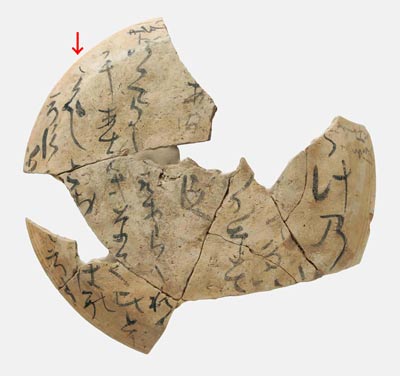
Among the oldest hiragana, ninth century, latter half The item at top is ink-inscribed pottery recovered from the pond remains, a Haji ware dish with hiragana written over almost the entire outer surface. A portion (arrow) can be read "people are hateful," thought possibly in the sense of "disagreeable," etc. The greatest surviving diameter is 14.0 cm.
|

Map of the Heian capital The mansion of Fujiwara no Yoshimi was at a prime location nearby Heian palace. Adapted from Hakkutsu sareta Nihon rettō 2014 [Excavations in the Japanese Archipelago, 2014] (Bunkachō [Agency for Cultural Affairs], ed., Asahi Shimbun Publications, 2014). |
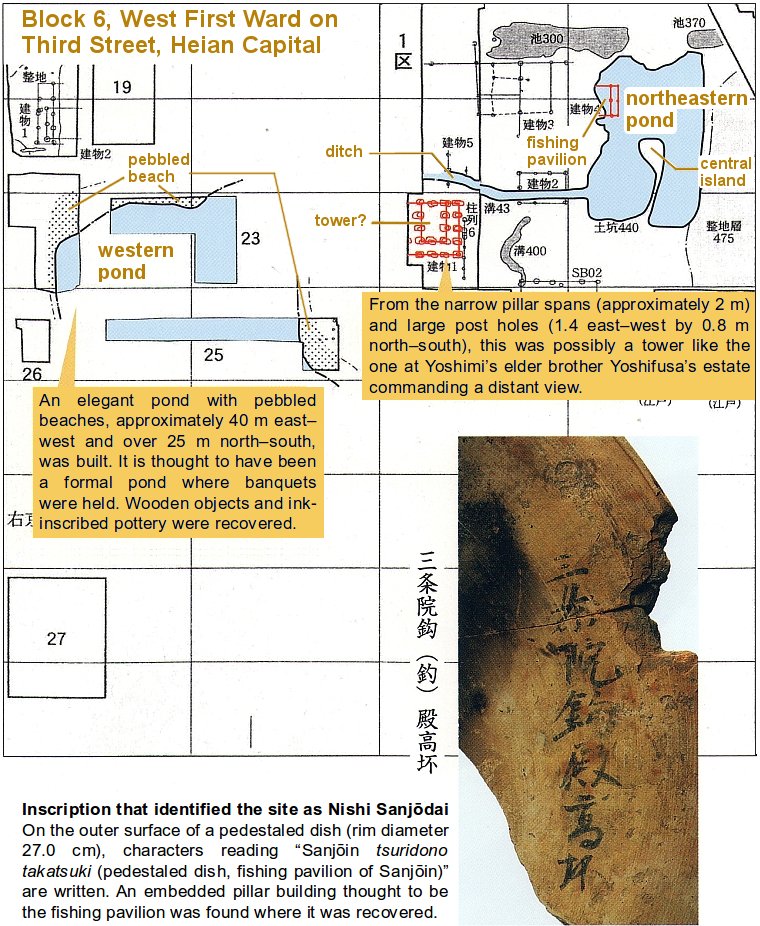
Plan of the features Adapted from Hakkutsu sareta Nihon rettō 2014 [Excavations in the Japanese Archipelago, 2014] (Bunkachō [Agency for Cultural Affairs], ed., Asahi Shimbun Publications, 2014). | |

Genealogical sketch of the Fujiwara, Hokke branch Yoshimi was the fifth child of Fuyutsugu, a court noble atthe start of the Heian period, his sister was Empress Dowager Nobuko, and his elder brother Yoshifusa, the Grand Minister of State, was the first person outside the imperial family to become Regent (sesshō). In Jōwa 9 (842), Yoshimi was dispatched during the Jōwa Conspiracy as Lieutenant of the Imperial Guards of the Left, and in the Ōtenmon Conspiracy of Jōgan 8 (866), on the advice of Senior Counselor Tomo no Yoshio, he dispatched troops to the mansion of Minamoto no Makoto, in opposition to his elder brother Yoshifusa. (Women's names are in italics; Emperors are boxed.) Adapted from Hakkutsu sareta Nihon rettō 2014 [Excavations in the Japanese Archipelago, 2014] (Bunkachō [Agency for Cultural Affairs], ed., Asahi Shimbun Publications, 2014). | |
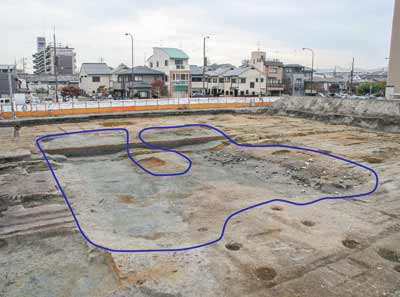
Remains of a pond with a central island (from the northeast) | |
Block 6, West First Ward on Third Street, Heian Capital Site, Kyoto City, Kyoto Prefecture
Remains of "Nishi Sanjōdai" determined
In the central portion of the modern city of Kyoto, Block 6 of the ancient Heian capital's West First Ward on Third Street has come to be the inferred location of the mansion of Fujiwara no Yoshimi, Minister of the Right in the Early Heian period. During excavation conducted in the 2011 fiscal year the remains of a pond were discovered, and in the processing of materials from the dig that continued to 2013, it became certain that the site was Fujiwara no Yoshimi's mansion.
The voluminous recovered materials included green-glazed stoneware, white porcelain, ink-inscribed pottery, and wooden implements, and among these were many examples of some of the oldest documentary materials written in kana (phonetic script).
A magnificent pond where Heian aristocrats took leisure
In the northeastern part of the grounds was a pond with a central island, while in the western portion was a pond with pebbles strewn on its banks to make pebbled beaches, with the two ponds connected by a ditch. At the west bank of the pond in the northeastern area, a tsuridono (fishing pavilion) jutting out over the water and a building thought to have been tower were found.
From the pond with the pebbled beaches a wooden spindle for a scroll was recovered, bearing the title "Sanjōin official warehouse registry, fourth year of the Saikō era," while from the pond with the central island came a Haji ware takatsuki (pedestaled dish for serving food) with an ink inscription reading "Sanjōin tsuridono takatsuki"; from these it became certain that the site was indeed the mansion of Fujiwara no Yoshimi, mentioned in the Nihon sandai jitsuroku (an official history completed in 901) by the name of Nishi Sanjōdai and in the Konjaku monogatarishū (a Heian period compilation of tales) as Nishi Sanjō. Saikō 4 (857) was the year Yoshimi took office as Minister of the Right. [Translation note: The suffix -in was applied to the residence of a retired emperor or empress, and is thought to have been used for the mansion because Yoshimi's elder sister, the Empress Dowager Fujiwara no Nobuko, dwelled there for a year, hence the appellation Sanjōin rather than Sanjōdai.]
An estate lasting but two generations
Also known as Hyakkatei (literally, "Hundred Flowers Estate") where cherry blossom viewings were held, the residence saw its glory in the days when Yoshimi's elder sister, the Empress Dowager Fujiwara no Nobuko, or Emperor Seiwa made excurions there. But after Yoshimi passed away in Jōgan 9 (867), and his son Tokitsura who inherited the residence died in Jōgan 17 (875), the estate disappeared from documentary sources, and from excavation it has been learned that this land was left unutilized from the tenth century on. That a prime location nearby the Heian palace fell into disuse after just two generations is a mystery.
Some of the oldest materials in hiragana
In addition, ink-inscribed pottery with writing in kana was recovered, including portions decipherable as hito nikushi to omohare ("people are hateful") and Katsuraki e ("to Kazuraki"). Examples of writing in kana from the latter half of the ninth century are rare nationwide, and the new finds far surpass discoveries to date in both quantity and quality. As there are many points of difference with kana writing of the tenth century, they are not yet fully deciphered. (Umase Tomomitsu)
(principal artifacts, Block 6, West First Ward on Third Street, Heian Capital Site)

Recovered pottery Early Heian, lattter half of the ninth century. (White porcelain bowl at lower left) Diameter: 14.0 cm. Pottery of the latter half of the ninth century was recovered from the pond in the northeast portion of the estate in both great volume and variety, filling 130 storage boxes and including white porcelain items imported from China, an extremely rare five-lobed bowl receptacle (second row from front, second item from left), high quality green-glazed stoneware produced at the Sanage kiln in Aichi prefecture (rightmost column), Haji ware dishes, and Sue ware. These items tell the lifestyle of the Early Heian period's high nobility. |
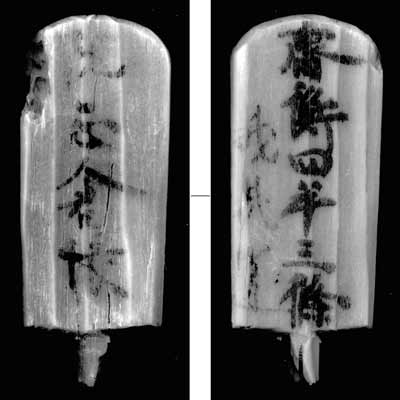
Labeled wooden scroll spindle Early Heian, lattter half of the ninth century. Length: 8.5 cm; width: 3.5 cm. In contrast to the pond from which most of the ink-inscribed pottery was recovered, this came from the pond on the western side of the estate. It is a spindle labeled to show the scroll's contents, and from the front to back sides is inscribed "Sanjōin official warehouse registry, fourth year of the Saikō era (857)." This is strong evidence the site was Fujiwara no Yoshimi's residence. (Infrared photo) |
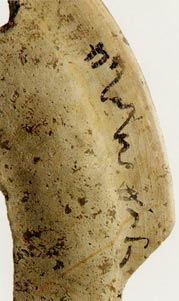 At bottom left is a Haji ware dish with hiragana written on the outer surface of the rim. It can be read "to Kazuraki," which is a phrase from the song "Asakura" used in kagura (Shinto ritual dance). It is not clear however whether this was the text of a kagura song. Length of the surviving portion is 6.5 cm.
At bottom left is a Haji ware dish with hiragana written on the outer surface of the rim. It can be read "to Kazuraki," which is a phrase from the song "Asakura" used in kagura (Shinto ritual dance). It is not clear however whether this was the text of a kagura song. Length of the surviving portion is 6.5 cm.